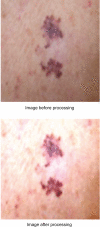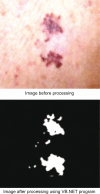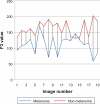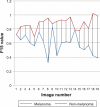Skin cancer recognition by using a neuro-fuzzy system
- PMID: 21340020
- PMCID: PMC3040073
- DOI: 10.4137/CIN.S5950
Skin cancer recognition by using a neuro-fuzzy system
Abstract
Skin cancer is the most prevalent cancer in the light-skinned population and it is generally caused by exposure to ultraviolet light. Early detection of skin cancer has the potential to reduce mortality and morbidity. There are many diagnostic technologies and tests to diagnose skin cancer. However many of these tests are extremely complex and subjective and depend heavily on the experience of the clinician. To obviate these problems, image processing techniques, a neural network system (NN) and a fuzzy inference system were used in this study as promising modalities for detection of different types of skin cancer. The accuracy rate of the diagnosis of skin cancer by using the hierarchal neural network was 90.67% while using neuro-fuzzy system yielded a slightly higher rate of accuracy of 91.26% in diagnosis skin cancer type. The sensitivity of NN in diagnosing skin cancer was 95%, while the specificity was 88%. Skin cancer diagnosis by neuro-fuzzy system achieved sensitivity of 98% and a specificity of 89%.
Keywords: fuzzy system; neural networks; neuro-fuzzy system; skin cancer.
Figures













Similar articles
-
A mathematical theory of shape and neuro-fuzzy methodology-based diagnostic analysis: a comparative study on early detection and treatment planning of brain cancer.Int J Clin Oncol. 2017 Aug;22(4):667-681. doi: 10.1007/s10147-017-1110-5. Epub 2017 Mar 20. Int J Clin Oncol. 2017. PMID: 28321787
-
Neuro-fuzzy system for prostate cancer diagnosis.Urology. 2006 Aug;68(2):357-61. doi: 10.1016/j.urology.2006.03.003. Urology. 2006. PMID: 16904452
-
A Novel Approach of Mathematical Theory of Shape and Neuro-Fuzzy Based Diagnostic Analysis of Cervical Cancer.Pathol Oncol Res. 2019 Apr;25(2):777-790. doi: 10.1007/s12253-019-00582-8. Epub 2019 Feb 6. Pathol Oncol Res. 2019. PMID: 30729412
-
Review of medical image recognition technologies to detect melanomas using neural networks.BMC Bioinformatics. 2020 Sep 14;21(Suppl 11):270. doi: 10.1186/s12859-020-03615-1. BMC Bioinformatics. 2020. PMID: 32921304 Free PMC article. Review.
-
Fuzzy logic systems and medical applications.AIMS Neurosci. 2019 Oct 22;6(4):266-272. doi: 10.3934/Neuroscience.2019.4.266. eCollection 2019. AIMS Neurosci. 2019. PMID: 32341982 Free PMC article. Review.
Cited by
-
Multiclass classification for skin cancer profiling based on the integration of heterogeneous gene expression series.PLoS One. 2018 May 11;13(5):e0196836. doi: 10.1371/journal.pone.0196836. eCollection 2018. PLoS One. 2018. PMID: 29750795 Free PMC article.
-
Enhanced convolutional neural network architecture optimized by improved chameleon swarm algorithm for melanoma detection using dermatological images.Sci Rep. 2024 Nov 6;14(1):26903. doi: 10.1038/s41598-024-77585-2. Sci Rep. 2024. PMID: 39505992 Free PMC article.
References
-
- Rigel DS, Friedman R, DZubow LM, et al. Cancer of the skin. Philadelphia: El Sevier Sanders; 2004. p. 736S.
-
- Whited JD, Hall RP. Diagnostic accuracy and precision in assessing dermatologic disease: problem or promise. Arch Dermatol. 1997;133:1409–15. - PubMed
-
- Schwartzbery JB, Elgart GW, Romanelli P, et al. Accuracy and predicators of based cell carcinoma diagnosis. Dermatol Surg. 2005;31:534–7. - PubMed
-
- Mogensen M, Jemec GBE. Diagnosis of non melanoma skin cancer/karatirocyte carcinoma: A review of diagnosis accuracy of non melanoma skin cancer diagnostic tests and technologies. Dermatol Surg. 2007;33:1158–74. - PubMed
LinkOut - more resources
Full Text Sources

